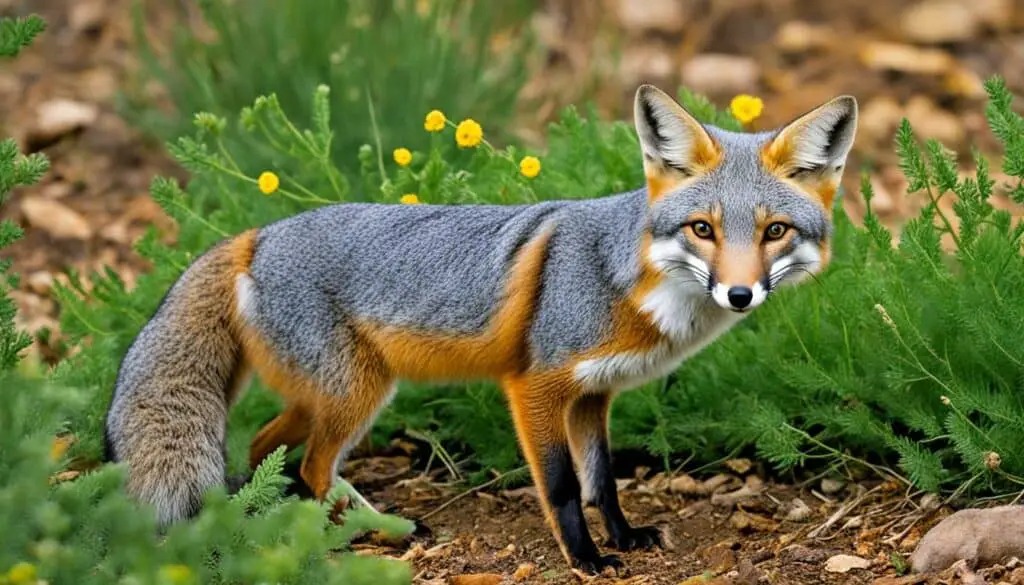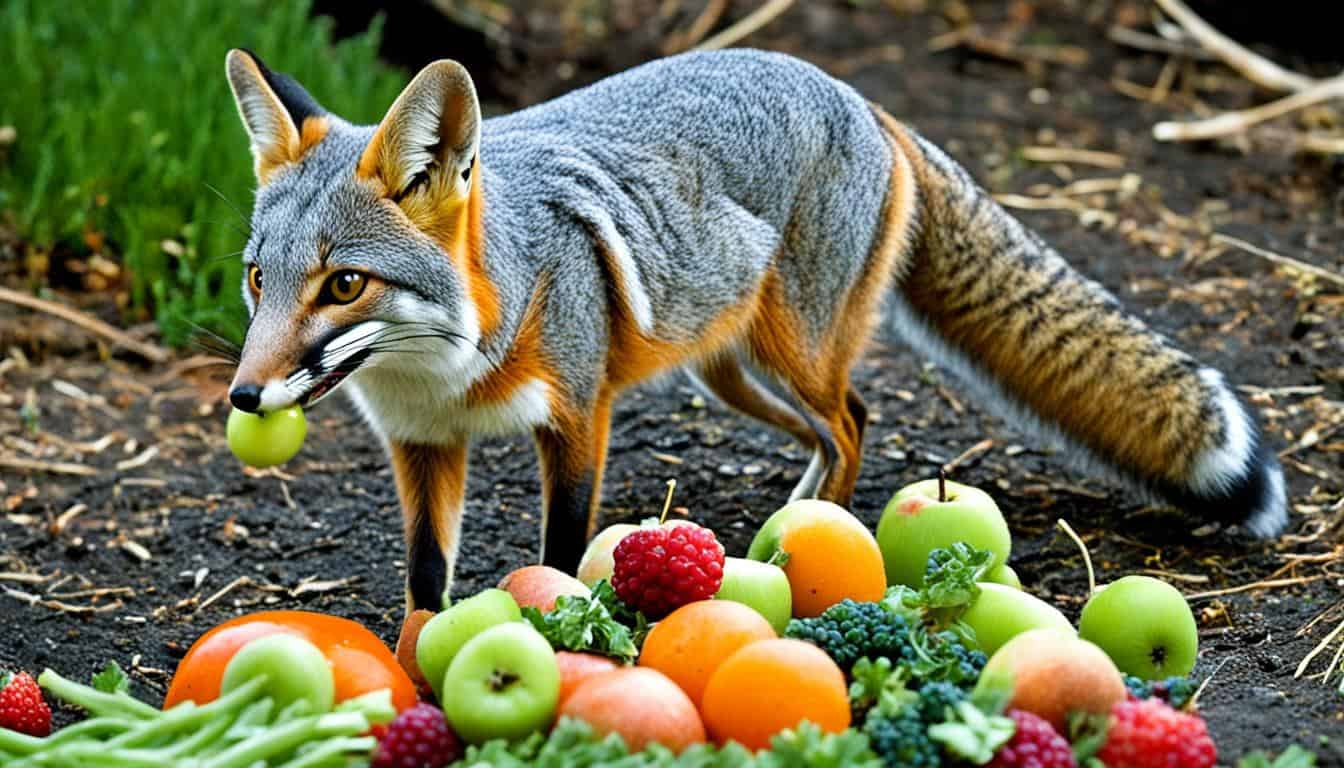Have you thought about what the elusive gray fox, Urocyon cinereoargenteus, eats in North Carolina? This fox is an omnivore with a varied diet that’s key for its home. It eats small mammals, birds, insects, and fruits like persimmons and wild grapes. Its diet is flexible, matching its diverse surroundings.
The gray fox also eats human-grown foods like corn and peanuts. These extra foods help keep animal numbers in check and spread seeds. Unlike the red fox, the gray fox excels near coyotes because it climbs trees to stay safe. Let’s find out more about the interesting diet of the gray fox.
Introduction to the Gray Fox
The gray fox (Urocyon cinereoargenteus) is a native species of North Carolina. It has been around for over a million years. While the red fox’s numbers are affected by hunting and trapping, the gray fox thrives. This is because it can climb trees to escape danger and find food high up.
The gray fox can live in many places, from thick forests to open farmlands. Its ability to do this shows how well it can adapt. It has short legs and a gray coat with dark markings, unlike the red fox. This makes it less popular for its fur.
In the late 1970s, people started using gray fox fur for coats and collars. Though the fur’s demand has decreased, there is still a market for it. The gray fox’s skill in finding different foods helps it survive, even with more coyotes around. This fact secures its place in North Carolina’s natural environment.
What is the diet of a gray fox?
Gray foxes eat a mix of foods that change with the seasons. This lets them do well in different places all year. They find new foods to stay healthy and strong.
Seasonal Variations
In spring and summer, gray foxes love eating plants, berries, and bugs. This helps them get all the vitamins and minerals they need. In fall and winter, they switch to eating more small animals. This change is key for keeping their energy up when it’s cold.
Opportunistic Feeding
Gray foxes are smart about what they eat, grabbing foods when they can. They enjoy crops like corn and nuts in the fall. This way, they stay strong and fat for winter. When food is plenty, they can bulk up and stay in good shape. Their skills at finding meals show their strength at living in many places.
Small Mammals in Gray Fox Diet
The gray fox eats many small mammals for nutrition and survival. They mainly eat creatures like mice, meadow voles, squirrels, and chipmunks. They also eat eastern cottontail rabbits and rats. These small animals give the foxes a lot of protein they need.
Types of Small Mammals
In the gray fox’s diet, you’ll notice a wide range of small animals. Mice and meadow voles are common because they are easy to find and catch. They also chase down squirrels and chipmunks, adding variety to their meals. Gray foxes also hunt rabbits and different rat species. Their varied diet shows how well they can find food all year.
Hunting Techniques
When hunting, gray foxes use their sharp eyes and ears more than their nose. Their great sense of vision and hearing helps them in dim light. They hunt by sneakily getting close to their prey and then jumping on them. They do a lot of their hunting at night, using the dark to stay hidden.
By eating these small mammals, gray foxes help keep nature in balance. This keeps their homes healthy. Knowing how gray foxes hunt helps us understand their place in the wild. It shows why it’s important to protect the places they live.
Fruits in Gray Fox Diet
The gray fox eats a lot of fruits along with other foods. This shows it can fit into many habitats and helps the environment. They keep themselves fed and help their home by spreading plants.
Common Fruits Eaten
Some fruits they eat are:
- Persimmons
- Grapes
- Strawberries
- Blueberries
- Blackberries
- Raspberries
- Huckleberries
- Apples
- Rosehips
They also eat farm crops like corn and peanuts. This shows how adaptable they are in finding food.
Impact on Ecosystem
Fruit-eating by gray foxes is good for the environment. It’s important for seed dispersal. Fruits they eat spread plant seeds when they poop, starting new plants elsewhere.
This helps grow new plants in forests. It keeps the area diverse and healthy, thanks to the gray fox.
Knowing about their fruit diet shows how they help nature stay balanced and varied.
Insects in Gray Fox Diet
Gray foxes eat many insects, adding variety to their diet. This is important for how they hunt. What’s interesting is that they eat more bugs when it’s warm. This shows how they can change what they eat based on the season.
They often eat crickets, grasshoppers, and beetles. By doing so, they help keep the number of these insects under control. Here, gray foxes show they are not just hunters. They play a key part in keeping the environment in balance.
In spring and summer, insects are a big part of what gray foxes eat. This is their way of making the most of what’s around. It also means they are good at adapting to different seasons. Plus, their diet helps make sure insect numbers don’t get too high, which is important for nature’s balance.
The fact that gray foxes eat insects tells us a lot. It gives us clues about how they hunt, what they eat each season, and their place in the ecosystem.
| Season | Primary Insects Consumed | Impact |
|---|---|---|
| Spring | Grasshoppers | Pest control |
| Summer | Crickets | Food source abundance |
| Fall | Beetles | Diverse diet |
Omnivorous Gray Fox
The gray fox is skilled at finding food in many habitats and times of year. It eats a mix of animals and plants which shows how it can live in many places. Knowing what the gray fox eats helps us see how it fits in its environment.

The gray fox can eat many different things. This makes it very good at surviving. Let’s see what foods it likes and when it likes to eat them:
| Type of Food | Examples | Seasonal Preference |
|---|---|---|
| Small Mammals | Rabbits, mice, squirrels | Winter |
| Fruits | Persimmons, wild grapes | Summer |
| Insects | Crickets, grasshoppers | Summer |
| Agricultural Products | Corn, peanuts | Fall |
The gray fox finds food in each season, which helps it live longer. It means they need to be good at looking for food. So, they are very clever about getting their meals. This skill helps them do well in forests and farms. Changing their diet with the seasons lets them handle different places. That’s how they keep finding food and stay healthy in many homes.
Seasonal Changes in Gray Fox Feeding Habits
The gray fox changes its diet throughout the year. This is because food availability shifts with the seasons. It’s interesting to see how they adapt their eating habits to survive in different environments.
Summer Diet
In summer, the gray fox eats more fruits and bugs. There’s lots of vegetation, so berries, apples, and persimmons are key foods. Insects, including crickets and grasshoppers, are also easy to find and offer them plenty to eat.
Winter Diet
When winter comes, the gray fox’s diet changes to more animal-based meals. With fewer fruits and insects around, they hunt for small mammals, rodents, rabbits, and birds. These animals help keep the foxes warm and energized in the cold. Eating high-protein foods is crucial for their winter survival.
These diet changes show how adaptable gray foxes are to their surroundings. They make the most of what’s available, which is a key to their survival all year round.
Hunting Behavior of Gray Fox
The hunting behavior of gray foxes is very interesting. It shows their ability to find food in smart ways. Unlike many other canids, they have special skills. These skills help them hunt well and survive in many places.
Foraging Techniques
Gray foxes show off amazing ways to find food. They can climb trees to catch birds or look for fruits. This is something quite different from other canids. Their quick movements help them catch small animals and bugs. This mix of skills lets them find food in many ways, making them strong hunters.
Adaptive Features
The features that help gray foxes adapt are key to their success in different areas. Their ability to climb is top-notch, thanks to strong claws and wrists that can rotate. This helps them get away from predators like coyotes. It also lets them reach food in trees where other ground predators can’t go. They’re also great at seeing and hearing well, which is super important for hunting. This makes them very good at finding and capturing prey.
Gray Fox and Human Interaction
Gray foxes and humans might not always get along. This is mainly due to conflicts like hunting domestic poultry and worries about diseases, such as rabies. Thankfully, these conflicts are not common. You can lower the chance of gray foxes attacking your livestock by managing wildlife properly. Keep your animals in secure enclosures.
Seeing gray foxes in suburban and rural places is okay. It shows the environment is healthy for them and other wildlife. To live safely with them, stay a respectful distance away. This helps avoid problems and lets everyone coexist safely.
To stop gray foxes from coming onto your property, take some steps. Make sure your trash is not easy for them to get into. Use fencing that they can’t jump over. Also, keep your pets and poultry safe at night. This means keeping them enclosed. Knowing how they behave and where they live can also help you. It helps you welcome these interesting animals to your area.
FAQ
What is the diet of a gray fox?
Gray foxes eat a wide range of foods. They like small mammals including mice, rats, and rabbits. Birds, insects, and fruits such as persimmons and grapes are part of their diet. They also eat crops like corn and peanuts.
How does the gray fox’s diet change seasonally?
In different seasons, gray foxes eat different things. Spring and summer see them munching on fruits, berries, and insects. When it gets cold, they turn to small mammals for more protein and fat.
What types of small mammals do gray foxes eat?
Mice, meadow voles, squirrels, chipmunks, rabbits, and rats are on the menu for gray foxes.
How do gray foxes hunt their prey?
Sharp eyes and ears help gray foxes hunt. They sneak up on their prey and jump to catch them. They mostly hunt at night.
What common fruits are part of the gray fox diet?
Persimmons, grapes, strawberries, and many more fruits are eaten by gray foxes. They help spread plant seeds as they eat these fruits.
How do gray foxes impact their ecosystem?
By eating small mammals and insects, they control pests. They also help plants grow by spreading fruit seeds.
Do gray foxes eat insects?
Yes, especially in warm weather. They snack on crickets, grasshoppers, and other insects. This helps control pests.
Are gray foxes omnivorous?
Yes, they are. Gray foxes eat both animals and plant matter. This includes small mammals, birds, fruits, and nuts.
How does the gray fox’s diet change from summer to winter?
Gray foxes eat more fruits, berries, and insects in the summer. But in winter, they hunt more small mammals for protein.
What foraging techniques do gray foxes use?
They climb trees for fruits and birds. On the ground, they jump and pounce on insects and small mammals.
How do gray foxes interact with humans?
Interactions with humans sometimes cause problems. Conflicts over poultry and disease can start. To avoid issues, keep animals away and stay a safe distance from them.







